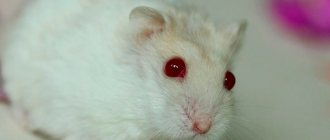The hamster's face is especially attractive and charming due to its small, slightly convex beady eyes. Physiological exophthalmos is the name given to the natural protuberance of the eyeballs in hamsters, which gives these rodents the ability to quickly navigate in space and notice danger in the form of predators. However, it happens that one or both eyes become too bulging, and this may indicate a disease.
You need to constantly monitor your hamster to understand if he is unwell
The hamster's eye has bulged out - what could be the reason?
You can tell if your hamster is unwell by watching him. The following signs indicate that an animal is sick:
- Refuses food and water;
- The rodent's fur becomes disheveled and unkempt;
- The animal generally behaves sluggishly and inactively;
- He loses weight very quickly.
You can tell that something wrong is happening with your little pet’s eyes using the following markers:
- Inflammatory process: redness, swelling.
- The appearance of pus;
- Inflamed eyelids close poorly;
- One or both eyes protrude unnaturally compared to the other.
Cloudy discharge indicates an infectious cause of inflammation, and clear discharge indicates an allergic reaction.
What are the reasons why hamsters' eyes fall out? There is only one reason: inflammation, but there can be several ways inflammation can occur. Globally: either due to injury or as a result of advanced disease.
Has your hamster been injured before?
As for mechanical injuries, it is quite easy to damage an animal’s eyes. An unsuccessful fall, the ingress of small particles of hay, feed, coarse dust particles - all this can damage the mucous membranes, cause suppuration and, as a result, loss.
Symptoms of bruise:
- Redness;
- Disorientation due to loss of vision;
- Nervousness of the animal.
Among the eye diseases that can lead to illness are:
- Advanced form of conjunctivitis;
- Glaucoma;
- Tumor.
IMPORTANT! Eye loss in a hamster is the last stage of the course of ophthalmological diseases.
At the initial stage, the eyes simply water.
With conjunctivitis, first one organ is affected, then another. The disease can be caused by small solid particles entering the mucous membranes. They are the ones who “trigger” the proliferation of bacteria and the pathological process. At the initial stage of the disease, the eyes may simply water, then cloudy discharge appears. They transform into pus over time. Constant inflammation leads to enlargement and prolapse of the eye socket.
Conjunctivitis can be recognized by symptoms:
1) Inflammation, swelling of the eyelids;
2) The appearance of purulent discharge in the corners, then throughout the entire eyelid;
3) Decreased appetite, general lethargy;
4) “Swimming”, the eyelids become narrow and stick together from pus.
This disease can be either infectious or allergic. In advanced forms of conjunctivitis, the inflammation progresses so much that the eyelids, on the contrary, are difficult to close, which leads to loss.
Glaucoma is a hereditary disease in which intraocular pressure increases. Not all hamsters suffer from this disease, only Campbell's.
Symptoms of glaucoma in hamsters:
- Increased intraocular pressure;
- Enlargement of the eyeball.
Without treatment, the eyeball bursts and leaks. Painful shock and repeated inflammation quickly lead to the death of the rodent.
Hamsters, unfortunately, are susceptible to cancer. When lumps or growths appear on the eyelid or close to the eye, it may indicate the formation of a tumor. As the tumor grows, it puts pressure on the eye and leads to eye loss.
You should consult a doctor immediately
How to identify eye diseases
Healthy pet eyes look bright and clean, without redness. There should be no discharge or crusting, swelling or sticking of the eyelids.
Important! Some breeds of hamsters initially have reddish eyes, so you need to observe how healthy they normally appear to watch for signs of injury or infection.
Hamsters are very often exposed to diseases and damage to the eyes, since the latter are on the protruding side and easily become dirty, poorly moisturized due to a reduced blink reflex.
Symptoms of eye diseases may include:
- redness of the edge of the eyelids;
- intense blinking;
- increased photosensitivity;
- itching and swelling;
- purulent discharge;
- active lacrimation or dryness;
- the appearance of a cloudy spot on the cornea;
- sticky eyelids;
- the eye is red, cloudy, swollen, hot to the touch;
- the eyeball bulges or falls out;
- pain when touched in the area of inflammation.
It is quite easy for a hamster to develop an eye infection, and it occurs in both old and young hamsters.
The reasons for this are numerous:
- allergies to bedding, especially if pine, cedar or other aromatic materials are used;
- dirty litter (cleaning must be done once a week);
- random bacteria on your hamster's food, such as a piece of apple or broccoli;
- infection from scratching the eyes while grooming;
- cold caused by draft;
- inflammation of the cheek pouch;
- low immunity and age-related changes;
- ingrown teeth (need to be trimmed every 2 weeks) begin to put pressure on the cheek and irritate the eyes.
Ocular bacterial infections are extremely dangerous for rodents. In case of damage and in the absence of prompt intervention, irreversible changes can occur, which can lead to deterioration and loss of vision and metastasis to the brain. The eyes may fall out, bulge out of their sockets, and leak.
Important! The sooner you contact a veterinary clinic, the greater the chance of saving the eyeball and preserving your pet’s vision.
What to do if your hamster's eye pops out?
If the hamster's eye has already popped out, then nothing can be done at home. Attempts to straighten or tuck the eye back will bring even more pain and stress to the animal. You should urgently contact a veterinarian , preferably a highly specialized veterinarian: a veterinarian or an ophthalmologist. A qualified doctor can accurately determine the cause of eye loss and take appropriate action.
REFERENCE! Veterinarians who specialize in the treatment of chinchillas, rats, hamsters and other rodents are called ratologists.
At home, you can help only in the early stages, and then, for the most part, by following preventive measures.
If it is conjunctivitis, then in the early stages appropriate treatment is prescribed: removal of purulent discharge using sterile cotton swabs soaked in saline solution or an aqueous solution of furatsilin. Any product applied to a cotton swab for subsequent processing should be slightly warmer or at room temperature. Treatment is carried out 3-4 times a day until visible improvements occur. If improvements do not occur within 2-3 days, then add drops containing antibiotics, such as Floxal, Tobrix, 1 cable up to 6 times a day for 5 days.
It is important to remember that open eye drops have a very short shelf life. Expired medicine should not be used.
Sometimes doctors prescribe systemic antibiotics, such as Baytril. However, they do not make much sense for treatment, since the eyeball is not permeable to antibiotics. But an ointment with an antibiotic inside, for example Floxal, can have a positive effect.
You cannot take long breaks in treatments, so your pet will have to wipe its eyes at night. Otherwise, in the morning the animal’s eyelids will constantly be stuck together from pus.
Ignoring treatment of conjunctivitis leads to the development of panophthalmitis, a disease in which protrusion occurs. At this stage, no treatment will help; only surgical removal is indicated.
For glaucoma, therapeutic treatment is impossible. Only surgical intervention through removal of the organ of vision is indicated. If no action is taken, the eye may burst, leak, and the animal will die from painful shock.
REFERENCE! There is also no treatment for cancerous tumors other than removal of the eye.
We emphasize that, unfortunately, if the eye has already fallen out, then in the clinic in 90% of cases the doctor will suggest removing the eye in order to save the animal’s life. The operation on small rodents is quite difficult and the hamster may die right in the hands of the surgeon, but such a procedure will at least give the animal a chance to survive.
Avoid spraying chemicals near the hamster cage
Why is conjunctivitis dangerous?
Conjunctivitis for hamsters is not at all the same as for humans. If a person can cope with this problem in a few days with the help of eye drops, then your pet does not have the opportunity to overcome the disease on its own. For this reason, you need to be wary if you notice at least one of the signs of conjunctivitis. It is worth considering that conjunctivitis, as a rule, is the very beginning of the pathology. Without taking appropriate measures, conjunctivitis will quickly turn into keratitis, followed by ulceration of the cornea of the eye. If a hamster's eye is swollen, but the owner does not pay any attention to it for a long time, then the rodent may go blind and then die.
The same dangers await the pets of their owners, who not only do not pay attention to the problem, but treat the pet incorrectly.
Under no circumstances should you self-prescribe pills to your pet or, even worse, give injections. This should only be done by an experienced veterinarian.
If you prevent your hamster from getting sick or detect it in time, you won’t have to think about why your hamster’s eye popped out and how to help him in such a situation. Often, due to late detection of the disease, pets completely lose their vision.
Preventive measures
To reduce the risk of diseases that can lead to eye loss, preventive measures should be taken in a timely manner. These include:
- Regular cleaning of the bedding in the hamster's cage;
- Avoid free walks around the apartment without a special ball so that the animal does not hurt itself on sharp corners or falls from a height.
- Avoid spraying chemicals or aerosols near the hamster's cage;
- Regular cleaning of dust near the animal’s cage;
- Balanced feeding and timely hygiene procedures;
- Regular examination of the animal and timely contact a veterinarian at the first signs of illness.
Video “Caring for Hamsters”
How to properly care for hamsters so that they never get sick is described in the video below. Video taken from the Rostovlife City Portal channel.
Sorry, there are no surveys available at this time.
Was this article helpful?
Thank you for your opinion!
The article was useful. Please share the information with your friends.
Yes (100.00%)
No
X
Please write what is wrong and leave recommendations on the article
Cancel reply
Rate the benefit of the article: Rate the author ( 5 votes, average: 4.20 out of 5)
Discuss the article:
Bulging eyes
This is more likely not a disease, but a consequence of injury to the eyeball, which has a bad effect on the general condition of the animal. A hamster can damage its eyes both in the fight against other rodents for survival and from dangerous objects contained in the cage - wood chips, sawdust, wire, etc.
As a result of injury, the invading pathogenic bacteria begins to rapidly multiply, penetrating even under the eyeball itself. Such a pet will most likely face surgery to remove the damaged organ. Otherwise, the bacterial infection can develop further, affecting the entire body. Then the rodent can no longer be saved.
Symptoms of the disease
Eye diseases in hamsters can be recognized by the following signs:
- the hamster's eye is very swollen and does not open;
- the eyelid area is always wet and sticks together;
- the hamster's eye waters, a purulent fluid of a grayish or yellowish color is constantly secreted, sometimes with blood;
- a stye or lump may appear;
- inflamed areas become red.
These are clear signs that there is inflammation inside the animal’s small body. This is why a hamster's eyes won't open. A sick pet will behave differently - its activity sharply decreases, it becomes inactive, and sleeps most of the time of the day. During this illness, hamsters may completely refuse to feed and drink.
This may be conjunctivitis, the treatment of which is very complex and lengthy. But often the hamster’s organ of vision turns sour and festers due to other diseases, which are much more difficult to cure. For example, if it’s a cold, the hamster’s eye festers, plus he may sneeze, cough, and wheezing appears in his breathing.
How to deal with this scourge? Our tips and recommendations below will help you with this. But first, we will list the main diseases of the organs of vision in the domestic hamster.
Treatment of diseases
After the examination and identification of the disease, the veterinarian prescribes treatment for his “little patient,” which consists of several stages:
- if a hamster’s eye festers, this is a sign of a bacterial infection that needs to be destroyed;
- saving the eyeball, if possible;
- reduce the risk of further damage to the organ of vision;
- numb the painful area;
- and only at the very end the specialist begins to treat the underlying disease that caused inflammation of the visual organs (glaucoma, dental disease, injury, etc.).
Consider one more point: the immunity of a sick rodent, like that of any pet, weakens during illness. Therefore, special attention should be paid to nutrition here. You can feed the animal only approved products. You should also exclude some permitted treats from your diet so as not to aggravate the course of the disease.
Dietary treatment consists of cereals, a small portion of animal protein. The animal's water needs to be changed several times a day.
If within a few days you have not noticed an improvement in the condition of your sick pet, you have no other choice but to take him to the veterinarian.
Prevention
Keeping your hamster healthy is easy.
- It is best to let your hamster out for walks in a ball, which will protect from injury and dust.
- It is prohibited to use hairsprays, sprays, or perfumes in the vicinity of the cage.
- You should not handle an animal with dirty hands, especially after contact with other animals.
- The bedding in the cage should be changed at least a couple of times a week.
- The food must be of high quality and suitable for the hamster. The drinking bowl must be washed daily.
A hamster's eyes are a delicate organ that often gets damaged. If pet hamsters show signs of illness, their eyelids stick together, despite all the care and a set of preventive measures, there is no need to delay contacting a specialist.
Timely treatment will protect your pet, improve its quality of life and allow it to live a long and happy life.
Agree, it is better to prevent any disease in domestic hamsters than to treat it later. And for this you need to create the necessary conditions for your pet. Considering the causes of such diseases, caring owners should:
- Use cage mats specifically designed for hamsters. Such material should not contain piercing or cutting objects, as well as a lot of dust.
- You should not keep a large number of rodents in one cage. They can injure each other, which will result in various diseases, including eye diseases.
- Genetically predisposed individuals must be immediately excluded from the general “herd.” Such hamsters can be a carrier of an infection from birth, transmitted to them from their mother or father.
- During the keeping process, the cage with rodents must be placed in a bright place, but protected from the sun. Direct exposure to sunlight and ultraviolet radiation negatively affects the health of pets.
- Regular examination of animals will help you at an early stage to identify not only carriers of diseases, but also to prevent the development of an already established disease in hamsters.
To avoid ophthalmic diseases, do not forget about preventive measures:
- Check your pet every day. Any changes in the normal state require medical diagnosis.
- Don't neglect cleaning. Change the water every day, washing the drinking bowl with soda, and the litter at least 2 times a week and be sure to carry out wet cleaning.
- Avoid bedding with sharp edges. Sharp wood chips lying under the paws pose a serious danger.
- Base your diet on quality foods that are suitable for rodents.
- Avoid constant access to sunlight. Bright light provokes the development of cataracts.
- Keep your hands clean to avoid infecting your hamster during close contact.
Prevention of eye health is the most important set of procedures that can reduce the risks of vision loss.
Loss of visual function is a serious problem that reduces quality of life.
When registering alarming symptoms, do not self-medicate. An incorrect diagnosis can worsen the condition.
Cleanliness is the key to health! To keep your beloved pet in excellent health, you must follow the rules of hygiene. The cage must be regularly cleaned of dirt, and all household items for the hamster must be disinfected. Water must be changed regardless of its consumption in order to prevent excessive proliferation of harmful bacteria. The absence of drafts also plays an important role, since light ventilation of the room can allow a fragile animal to pass through.
A simple and, most importantly, the most effective way to prevent sour eyes is proper nutrition. Do not give your animal fruits and vegetables of unknown origin, and do not feed foods with various questionable additives. And remember that natural organic food has never harmed anyone.
The hamster is a generally healthy and active rodent. Many owners of these funny animals don’t even think about what diseases their pets may have, because they have never encountered them. Hamsters are susceptible to diseases no less than other pets, but diagnosing an illness and treating a miniature pet is much more difficult than, say, a cat or dog. Especially when it comes to such an important and fragile organ as the eyes. So, if your hamster’s eyes are festered or swollen, what should a loving owner do? Let’s try to figure it out!
[Hide]
Blepharitis
This disease may be a consequence of advanced conjunctivitis. In this case, the inflamed eyelid sticks together, and the inflammatory process spreads deeper and deeper inside. At an advanced stage, both organs of vision may be closed. This disease is accompanied by redness and swelling of the eyelids.
What to do in this case? This disease can be treated if you consult a veterinarian in time. Often the treatment regimen is identical to the treatment regimen for conjunctivitis. Often, special eye drops are used in the treatment of this disease, for example Tsiprovet or Floxal, as well as additionally tetracycline ointment.
With this disease, the hamster should be put on a diet and the cage should be disinfected.
Blepharitis is a complication of advanced conjunctivitis. With this pathology, the inflammatory process completely engulfs the eyelids, causing them to become poisonous red. The fur begins to come out all over the face. The animal suffers from severe itching, the hamster constantly rubs its sore eyes. Also, the eyelids swell greatly, sometimes acquiring a bluish tint.
The treatment of this disease is similar to the treatment of conjunctivitis. However, drops alone are not enough. In addition to them, tetracycline ointment should be used. It is used to treat the eyelids from the outside 2-3 times a day.
Of course, before dripping medicine into the eyes, they must be washed and the accumulated pus removed. This can be done with chamomile infusion or tea.
What is meant by unsanitary conditions?
Lack of proper care is the most common reason why a hamster's eye festers. Of course, unsanitary conditions for keeping an animal primarily mean infrequent cleaning.
Paradoxical as it may seem, hamsters that are kept in special cages for rodents or in enclosures designed for them are the most likely to get sick from dirt. Less often than others, pets living in jars, old aquariums, and bird cages get sick.
Why is this happening? It's all about the design of the bottom of the rodent's home. In special cages it is double, and the owners simply do not immediately notice that they need to tidy up. Fumes from urine and feces swelling in it, fallen grains and pieces of other food corrode the cornea and cause a severe allergic reaction. In jars, aquariums and bird cages there is no double bottom, and a person immediately notices when it is necessary to clean a pet’s home.
However, people who regularly clean enclosures or cages often wonder what to do if a hamster’s eye festers. Since owners do not allow dirt on the pallet, they rarely associate inflammation of the small pet’s organs of vision with unsanitary conditions. Meanwhile, people often buy various houses, labyrinths and other cute objects for their hamsters, in which rodents love to spend time and set up storage rooms. But their owners often forget to wash these houses and labyrinths.











